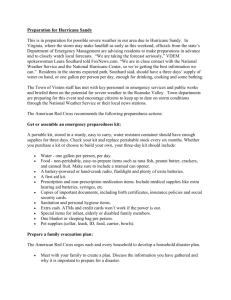Family Disaster Plan and Personal Survival Guide Family Disaster
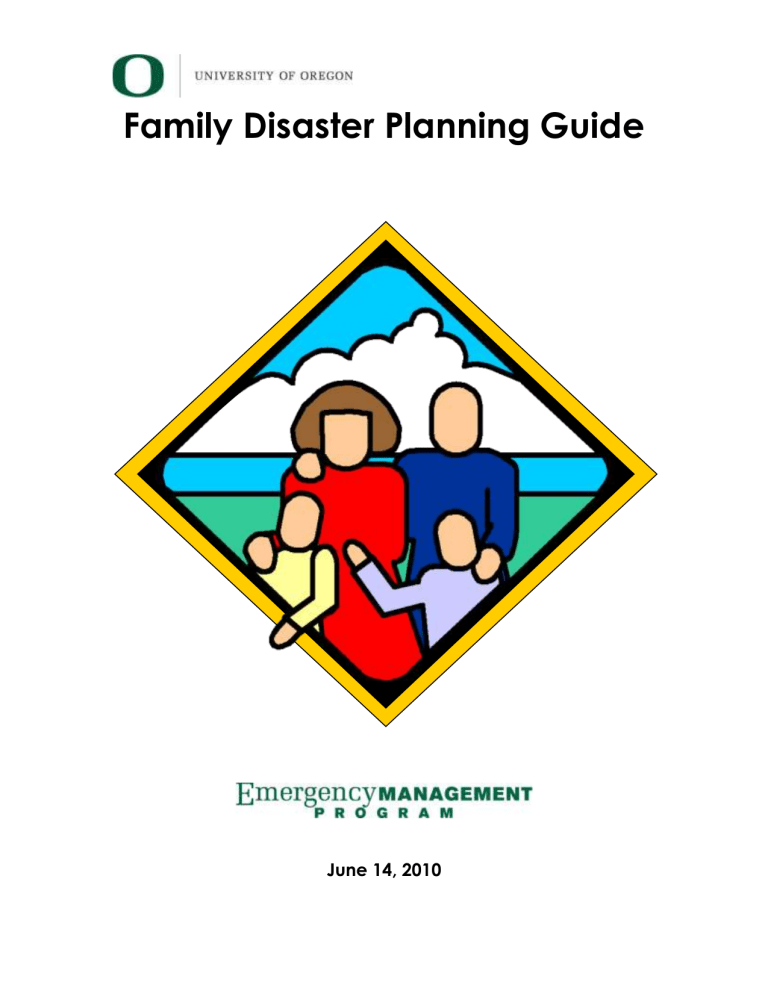
Family Disaster Planning Guide
June 14, 2010
About your Family Disaster Plan
There are many different kinds of disasters, such as fires, floods, airplane crashes, chemical spills, pipeline leaks and explosions, which seldom give warning and can be equally devastating to their victims. The planning you and your family do now will be of benefit for any type of disaster that can strike your community.
This guide is a plan template and is intended to provide you a simple format and possible suggestions about information you might want to include in your family disaster plan. It is not all inclusive and should be modified by the user to suit individual or family needs.
This plan can be filled in electronically or printed and filled in by hand. If filled in by hand, we recommend that you use a pencil for ease of making future corrections to information contained in the document.
At least once a year, have a meeting with your family to discuss and update your disaster plan with current and correct information. Determine what additional training, equipment, and supplies are needed.
Practice! Occasional drills can improve reaction time and help to avoid panic in an actual emergency.
Update and review plan Last update Next update
http://em.uoregon.edu/
Page | 2
Table of Contents
Household Members and Pets Inventory 4
Household Information
Emergency Numbers
Utility and Service Contracts
Insurance and Other Information
Family/Friends/Neighbors
Out of Area Contact Information
Work and School Contacts
Reunion Procedures
Medication List
Pharmacy/Doctors/Specialists
Additional Medical Information
Home Layout/Diagram
Utility Control
4
5
5
6
6
7
8
9
10
11
12
13
14
Practice Your Plan
Preparing a Disaster Supplies Kit
Pet Plan
Notes
15
16
23
24
This template was adapted from Patrick Air Force Bases’ Family Disaster Plan. For more information, visit the UO
Emergency Management website: http://em.uoregon.edu
http://em.uoregon.edu/
Page | 3
Household Members
Household Members
Relation/Birth Date Social Security Number
Pets
PETS
Pet License # Vet name & phone
Household Information
Home Address:
Phone1:
E-mail 1:
E-mail 2:
Phone2: http://em.uoregon.edu/
Page | 4
Car 1: Make
Car 2: Make
Car 3: Make
Car Information
/ Model
/ Model
/ Model
/ Year
/ Year
/ Year
/ License #
/ License #
/ License #
Emergency Numbers
CALL 911 FOR EMERGENCY
Note: After a disaster, 911 may not be working. Use these numbers when able.
Fire Phone Address
Police
Ambulance
Poison Control Center
Hospital Emergency
Room
Doctor #1
Doctor #2
Doctor #3
Water/Sewer
Electric
Gas
Phone
Cable
Phone
Phone
Phone
Phone
Phone
Phone
Phone
Utility and Service Contacts
Phone Address
Phone
Phone
Phone
Phone
Address
Address
Address
Address
Address
Address
Address
Address
Address
Address
Address http://em.uoregon.edu/
Page | 5
Policy Name
Insurance
Policy #
Health
Auto
Home
Life
Family/Friends/Neighbors
Note: Identify two neighbors. Agree to check on each other
Name:
Address/Location:
Home #:
E-mail:
Name:
Address/Location:
Home #:
E-mail:
Name:
Address/Location:
Home #:
E-mail:
Work #:
Work #:
Work #:
Cell #:
Cell #:
Cell #:
Phone http://em.uoregon.edu/
Page | 6
Out-of-Area Contact
Name and telephone number of person outside your local area for family members to call to report their location and condition. Everyone should memorize this number! Also select an alternate contact just in case the primary contact cannot be reached.
Important: During disasters, use phone for emergencies only. Local phone lines may be tied up. Make one call out-of-area to report in. Let this person contact others.
Primary Contact Information
Name:
Home Address:
Work #: Cell #: Home #:
E-mail:
Alternate Contact Information
Name:
Home Address:
Home #:
E-mail:
Work #: Cell #: http://em.uoregon.edu/
Page | 7
Work, School, and Other Contacts
Family members should know each other’s disaster procedures for work, school, or other places where they spend time during the week.
Family Member:
Address:
Disaster Procedures:
Family Member:
Address:
Disaster Procedures:
Family Member:
Address:
Disaster Procedures:
Family Member:
Address:
Disaster Procedures:
Work/School/Other:
Work/School/Other:
Work/School/Other:
Work/School/Other:
Phone #:
Phone #:
Phone #:
Phone #:
In case of emergency, you should know if the school will keep your children until an authorized adult comes to get them. Determine what is required to release your child to your representatives if you cannot get there yourself. Ensure that the school knows your current contact information and those people authorized to collect your children. http://em.uoregon.edu/
Page | 8
Reunion Procedures
Establish two places where you and your family can meet following an emergency. One immediately outside of your home, e.g. a neighbor’s mailbox, for use during a home emergency AND another site away from home in case you can’t return.
Inside House/Apartment In or Around
House/Apartment
Outside House/Apartment
When Family is
Not Home
Priority Location
(Leave note in a designated place such as inside mailbox where you will be: i.e., neighbor, relative, park, school, shelter, etc.)
Note: Reunion and evacuation procedures need to include children at school and house members with disabilities. Talk to school officials. Write down procedures.
Important Notes and Procedures
Note: People with disabilities are advised to identify two or three people at work, school, neighborhood, etc. who will assist them in the event of a disaster. http://em.uoregon.edu/
Page | 9
User’s Name
Doctor
Medication List
Medication
Name
Dosage/Frequency
Prescription #
Reason for Taking
Date Started/Ending Location of Meds
User’s Name
Doctor
Medication
Name
Prescription #
User’s Name
Doctor
Medication
Name
Prescription #
User’s Name
Doctor
Medication
Name
Prescription #
Dosage/Frequency Reason for Taking
Date Started/Ending Location of Meds
Dosage/Frequency Reason for Taking
Date Started/Ending Location of Meds
Dosage/Frequency Reason for Taking
Date Started/Ending Location of Meds
User’s Name
Doctor
Medication
Name
Prescription #
Dosage/Frequency Reason for Taking
Date Started/Ending Location of Meds
Note: Keep at least seven days of vital medications and supplies on hand. Talk to doctor before storing medication or if you use two or more medications. Take them with you if you have to evacuate to a shelter, friend’s house, or other family member’s home. http://em.uoregon.edu/
Page | 10
Pharmacy/Doctors/Specialists
Pharmacist Name:
Pharmacy Name: Address:
Phone #:
Phone #: Pharmacist Name:
Pharmacy Name:
Specialist Name:
Organization:
Area of Concern:
Specialist Name:
Organization:
Area of Concern:
Specialist Name:
Organization:
Area of Concern:
Specialist Name:
Organization:
Area of Concern:
Specialist Name:
Organization:
Area of Concern:
Address:
Address:
Address:
Address:
Address:
Address:
Phone #:
Phone #:
Phone #:
Phone #:
Phone #: http://em.uoregon.edu/
Page | 11
Person’s Name:
Additional Medical Information
Allergies to Medications
Medication:
Person’s Name:
Person’s Name:
Person’s Name:
Person’s Name:
Medication:
Medication:
Medication:
Medication:
Person’s Name:
Person’s Name:
Person’s Name:
Person’s Name:
Person’s Name:
Health/Disability Information
Information:
Information:
Information:
Information:
Information:
Person’s Name:
Person’s Name:
Person’s Name:
Special Needs, Equipment, and Supplies
Information:
Information:
Information:
Person’s Name:
Person’s Name:
Information:
Information:
Note: Fill this and all sections out in pencil. Update regularly. If additional information is needed, tape or staple another sheet of paper. http://em.uoregon.edu/
Page | 12
Home Layout/Diagram
Draw a floor plan of your home showing the location of exit doors and windows, utility shutoffs, first aid kit, and emergency supplies. Ensure EVERYONE in your household is familiar with it. Show it to babysitters and house guests when you're going away. http://em.uoregon.edu/
Page | 13
Utility Control
Locate each of these utility control points in your home.
Electricity: In the event that you need to turn off the electricity in your house, go to the breaker box and do the following:
1. Turn off smaller breakers one by one
2. Flip the “main” breaker to off last
To reenergize your home, reverse the steps above
Water: In the event you need to shut water off inside your home, find the main water valve and turn it to your right. To open the flow of water back into the house, turn it to your left.
Gas: IMPORTANT – Only turn off you gas at the meter if you smell gas!
To turn off natural gas in your house, take a wrench and tighten it on to the quarter turn valve that is on the pipe that feeds into the gas meter. Turn it one quarter turn to make the indicator parallel to the ground. In most locations, once you do this you cannot turn the gas back on to the house without the utility company.
Propane: If you live in an area that uses outdoor propane or LPG you will find this outside the home. Open the top of the tank and you will see either a regular turn knob or a quarter turn valve. Turn the knob to your right to shut off the flow of propane into your house. For quarter turn valve see above. http://em.uoregon.edu/
Page | 14
Practice Your Plan
Once you have developed your plan, you need to practice and maintain it. Practicing your plan will help your family instinctively take the appropriate actions during an actual emergency; even in the middle of the night. You should review your plan at least annually and make updates as necessary.
Quiz your kids every six months so they remember what to do, meeting
places, phone numbers, and safety rules.
Conduct fire and emergency evacuation drills at least twice a year. Actually drive evacuation routes so each driver will know the way. Select alternate routes in case the main evacuation route is blocked during an actual disaster. Mark your evacuation routes on a map; keep the map in your disaster supplies kit. Remember to follow the advice of local officials during evacuation situations. They will direct you to the safest route, away from roads that may be blocked or put you in further danger.
Replace stored food and water every six months. Replacing your food and water supplies will help ensure freshness.
Use the test button to test your smoke alarms once a month. The test feature tests all electronic functions and is safer than testing with a controlled fire
(matches, lighters, or cigarettes). If necessary, replace batteries immediately.
Make sure children know what your smoke alarm sounds like.
If you have battery-powered smoke alarms, replace batteries at least once a
year. Some agencies recommend you replace batteries when the time changes from standard daylight savings each spring and again in the fall.
"Change your clock, change your batteries," is a positive theme and has become a common phrase.
Replace your smoke alarms every 10 years. Smoke alarms become less sensitive over time. Replacing them every 10 years is a joint recommendation by the National Fire Protection Association and the U.S. Consumer Products
Safety Commission.
Look at your fire extinguisher to ensure it is properly charged. Fire extinguishers will not work properly if they are not properly charged. Use the gauge or test button to check proper pressure. Follow manufacturer’s instructions for replacement or recharging fire extinguishers. If the unit is low on pressure, damaged, or corroded, replace it or have it professionally serviced. http://em.uoregon.edu/
Page | 15
Preparing a Disaster Supplies Kit
You may need to survive on your own after a disaster. This means having your own food, water, and other supplies in sufficient quantity to last for at least three days. Local officials and relief workers will be on the scene after a disaster, but they cannot reach everyone immediately. You could get help in hours, or it might take days.
Basic services such as electricity, gas, water, sewage treatment, and telephones may be cut off for days, or even a week or longer. Or, you may have to evacuate at a moment’s notice and take essentials with you. You probably will not have the opportunity to shop or search for the supplies you need.
A disaster supplies kit is a collection of basic items that members of a household may need in the event of a disaster.
Kit Locations
Since you do not know where you will be when an emergency occurs, prepare supplies for home, work, and vehicles.
Home Work Car
Your disaster supplies kit should contain essential food, water, and supplies for at least three days.
Keep this kit in a designated place and have it ready in case you have to leave your home quickly. Make sure all family members know where the kit is kept.
Additionally, you may want to consider having supplies for sheltering for up to two weeks.
This kit should be in one container, and ready to "grab and go" in case you are evacuated from your workplace.
Make sure you have food and water in the kit. Also, be sure to have comfortable walking shoes at your workplace in case an evacuation requires walking long distances.
In case you are stranded, keep a kit of emergency supplies in your car.
This kit should contain food, water, first aid supplies, flares, jumper cables, and seasonal supplies. http://em.uoregon.edu/
Page | 16
What should I put my family’s disaster supplies kit in?
Disaster supplies kits can be large or small depending on how many persons you have to gather supplies for in your household.
Your emergency supplies should be sufficient to sustain you, your family and pets for a minimum of
72 hours. A two (2) week supply of medicines and prescription drugs is recommended. This may make a difference in what type of container you utilize for your kit.
Next, remember that you may not be the one picking up or carrying the disaster supplies kit. Everyone should be able to get the kit and evacuate the home quickly. Some containers have wheels, some have straps and carrying handles to make evacuating quicker and easier.
Below are some options of types of containers to use for your disaster supplies kit.
You may have something to use already or you may need to purchase them.
Either way you will need something dedicated for your disaster supplies kit. Mark it clearly so that everyone is aware of the contents.
How long can food supplies be stored?
To judge how long you can store food supplies, look for an “expiration date” or
“best if used by” date on the product. If you cannot find a date on the product, then the general recommendation is to store food products for six months and then replace them.
Some households find it helpful to pull food products for their regular meals from their disaster supplies kit and replace them immediately on an ongoing basis, so the food supplies are always fresh. http://em.uoregon.edu/
Page | 17
What kinds of food supplies are recommended to store in case of a disaster?
Avoid foods that are high in fat and protein, and don’t stock salty foods, since they will make you thirsty. Familiar foods can lift morale and give a feeling of security in time of stress. Also, canned foods won’t require cooking, water or special preparation. Take into account your families unique needs and tastes. Try to include foods that they will enjoy that are high in calories and nutrition.
Store supplies of non-perishable foods and water in a handy place. You need to have these items packed and ready in case there is no time to gather food from the kitchen when disaster strikes.
Select foods that require no refrigeration, preparation or cooking, and little or no water. Foods that are compact and lightweight are easy to store and carry.
Try to eat salt-free crackers, whole grain cereals and canned food with high liquid content.
Recommended Foods
Ready-to-eat canned meats, fruits and vegetables. (Be sure to include a manual can opener)
Canned juices, milk and soup (if powdered, store extra water).
High-energy foods, such as peanut butter, jelly, crackers, granola bars and trail mix.
Comfort foods, such as hard candy, sweetened cereals, candy bars and cookies.
Instant coffee, tea bags.
Foods for infants, elderly persons or persons on special diets, if necessary.
Dried foods. They can be nutritious and satisfying, but have some have a lot of salt content, which promotes thirst. Read the label.
Freeze-dried foods. They are tasty and lightweight, but will need water for reconstitution.
Instant Meals. Cups of noodles or cups of soup are a good addition, although they need water for reconstitution.
Snack-sized canned goods.
Good because they generally have pull-top lids or twist-open
Compressed food bars. They store well, are lightweight, taste good and are nutritious.
Trail mix. It is available as a prepackaged product or you keys.
Prepackaged beverages. Those in foil packets and foil-lined boxes are suitable because they are tightly sealed and will keep for a can assemble it on your own.
Foods to Avoid long time
Commercially dehydrated foods. They can require a great deal of water for reconstitution and extra effort in preparation.
Bottled foods. They are generally too heavy and bulky, and break easily.
Meal-sized canned foods. They are usually bulky and heavy.
Whole grains, beans, pasta. Preparation could be complicated under the circumstances of a disaster. http://em.uoregon.edu/
Page | 18
What is the basis for the Red Cross recommendation to store supplies to last several days to a week?
The American Red Cross recommendations to have food, water, and other emergency supplies on hand are not new, and are considered reasonable in case of any disaster. Our recommendations are to have supplies to last several days to a week. Most reasonable people would not consider such quantities of supplies as a "stockpile" or "hoarding."
Some families may choose to store supplies to last several weeks or more.
Certainly, if they wish to do so, they may. It is always wise to have sufficient food and water supplies on hand in case access to such supplies may be disrupted by a disaster.
How Much Water do I Need?
You should store at least one gallon of water per person per day. A normally active person needs at least one-half gallon of water daily just for drinking.
Additionally, in determining adequate quantities, take the following into account:
Individual needs vary, depending on age, physical condition, activity, diet, and climate.
Children, nursing mothers, and ill people need more water.
Very hot temperatures can double the amount of water needed.
A medical emergency might require additional water.
How Should I Store Water?
To prepare safest and most reliable emergency supply of water, it is recommended you purchase commercially bottled water. Keep bottled water in its original container and do not open it until you need to use it. Observe the expiration or “use by” date.
If you are preparing your own containers of water
It is recommended you purchase food-grade water storage containers from surplus or camping supplies stores to use for water storage. Before filling with water, thoroughly clean the containers with dishwashing soap and water, and rinse completely so there is no residual soap. Follow directions below on filling the container with water.
If you choose to use your own storage containers, choose two-liter plastic soft drink bottles – not plastic jugs or cardboard containers that have had milk or fruit juice in them. Milk protein and fruit sugars cannot be adequately removed from these containers and provide an environment for bacterial growth when water is http://em.uoregon.edu/
Page | 19
stored in them. Cardboard containers also leak easily and are not designed for long-term storage of liquids. Also, do not use glass containers, because they can break and are heavy.
If storing water in plastic soda bottles, follow these steps
Thoroughly clean the bottles with dishwashing soap and water, and rinse completely so there is no residual soap. Sanitize the bottles by adding a solution of 1 teaspoon of non-scented liquid household chlorine bleach to a quart of water. Swish the sanitizing solution in the bottle so that it touches all surfaces.
After sanitizing the bottle, thoroughly rinse out the sanitizing solution with clean water.
Filling water containers
Fill the bottle to the top with regular tap water. If the tap water has been commercially treated from a water utility with chlorine, you do not need to add anything else to the water to keep it clean. If the water you are using comes from a well or water source that is not treated with chlorine, add two drops of non-scented liquid household chlorine bleach to the water. Tightly close the container using the original cap. Be careful not to contaminate the cap by touching the inside of it with your finger. Place a date on the outside of the container so that you know when you filled it. Store in a cool, dark place.
Replace the water every six months if not using commercially bottled water.
First Aid Supplies
Anatomy of a First Aid Kit
First Aid kits come in many shapes and sizes.
You can purchase one from a drug store, or you can make your own kit. Kits are designed for a variety of locations including your home, office or automobile. They're also important to have for special activities such as hiking, camping or boating. Whether you buy a
First Aid kit or put one together yourself, make sure it has all the items you need to be prepared for emergencies. See the inventory list below but also be sure to include any personal items, such as medications and emergency phone numbers, or items your physician may suggest. Check the kit regularly to make sure flashlight batteries work, out-of-date contents are replaced, and expiration dates are current. Remember, the contents of a first aid kit can be dangerous in the hands of young children, so store your first aid kit in a secure place. http://em.uoregon.edu/
Page | 20
First Aid Kit Suggestions
First Aid Cream
Triangular Bandage
First Aid Tape
Gauze Pads and Roller Gauze
(assorted sizes)
Antibacterial Ointment
Hand Wipes
Disposable Gloves
Hand Sanitizer
Rescue Breathing Barrier
Pencil and Notepad
Antiseptic Wipes
Plastic Bags
Band-Aids (assorted sizes)
Blanket
Scissors and Tweezers
Cold Pack
Small Flashlight and Extra
Batteries
Combined Sterile Dressings
SOS Banner
Gauze Pads and Roller Gauze
(assorted sizes)
Sting Relief Pads
Conforming Bandages
Syrup of Ipecac (use only if instructed by Poison Control
Center)
Safety Pins
Tools, Supplies, Clothing and Bedding
Supplies and Tools
Mess kits, or paper cups, plates, and plastic utensils
Emergency preparedness manual
Battery-operated radio and extra batteries
Flashlight and extra batteries
Cash or traveler's checks, change
Non-electric can opener, utility knife
Fire extinguisher: small canister
ABC type
Tube tent
Pliers
Tape
Sanitation
Toilet paper, towelettes
Soap, liquid detergent
Feminine supplies
Personal hygiene items
Compass
Matches in a waterproof container
Aluminum foil
Plastic storage containers
Signal flare
Paper, pencil
Needles, thread
Medicine dropper
Shut-off wrench to turn off household gas and water
Whistle
Plastic sheeting
Map of the area (for locating shelters)
Plastic garbage bags, ties (for personal sanitation uses)
Plastic bucket with tight lid
Disinfectant
Household chlorine bleach http://em.uoregon.edu/
Page | 21
Clothing and Bedding
Include at least one complete change of clothing and footwear per person.
Sturdy shoes or work boots
Rain gear
Blankets or sleeping bags
Hat and gloves
Thermal underwear
Sunglasses
Special Items and Important Family Documents
Remember family members with special requirements.
For Baby
Formula Powdered milk
Medications Diapers
Bottles
For Adults
Heart and high blood pressure medication
Insulin
Prescription drugs
Denture needs
Contact lenses and supplies
Extra eyeglasses
Non-Prescription Drugs
Aspirin or non-aspirin pain reliever
Anti-diarrhea medication
Antacid (for stomach upset)
Syrup of Ipecac (use to induce vomiting if advised by the Poison
Control Center)
Laxative
Activated charcoal (use if advised by the Poison Control
Center)
Important Family Documents (Store in a waterproof, portable container)
Will, insurance policies, contracts deeds, stocks and bonds
Inventory of valuable household goods, important telephone
Passports, social security cards, immunization records
Bank account numbers
Credit card account numbers and companies numbers
Family records (birth, marriage, death certificates)
Copy of Family Disaster Plan http://em.uoregon.edu/
Page | 22
Maintaining Your Disaster Supplies Kit
Just as important as putting your supplies together is maintaining them so they are safe to use when needed. Here are some tips to keep your supplies ready and in good condition:
Keep canned foods in a dry place where the temperature is cool. Throw out any canned good that becomes swollen, dented, or corroded.
Store boxed food in tightly closed plastic or metal containers to protect from pests and to extend its shelf life.
Place new items at the back of the storage area and older ones in the front.
Change stored food and water supplies every six months. Be sure to write the date you store it on all containers.
Re-think your needs every year and update your kit as your family needs change.
Keep items in airtight plastic bags and put your entire disaster supplies kit in one or two easy-to-carry containers, such as an unused trashcan, camping backpack, or duffel bag.
Pet Plan
Contact your veterinarian or local humane society for information on preparing your pets for an emergency.
Before The Disaster
Make sure that your pets are current on their vaccinations. Pet shelters may require proof of vaccines.
Have a current photograph
Keep a collar with identification on your pet and have a leash on hand to control your pet.
Have a properly-sized pet carrier for each animal - carriers should be large enough for the animal to stand and turn around.
Plan your evacuation strategy and don't forget your pet! Specialized pet shelters, animal control shelters, veterinary clinics and friends and relatives out of harm's way are ALL potential refuges for your pet during a disaster.
If you plan to shelter your pet - work it into your evacuation route planning.
During The Disaster
Animals brought to a pet shelter are required to have: Proper identification collar and rabies tag, proper identification on all belongings, a carrier or cage, a leash, an ample supply of food, water and food bowls, any necessary medications, specific care instructions and news papers or trash bags for clean-up.
Bring pets indoors well in advance of a storm.
Pet shelters will be filled on first come, first served basis. Call ahead and determine availability. http://em.uoregon.edu/
Page | 23
After The Disaster
Walk pets on a leash until they become re-oriented to their home - often familiar scents and landmarks may be altered and pets could easily be confused and become lost. Also, downed power lines, reptiles brought in with high water and debris can all pose a threat for animals after a disaster.
If pets cannot be found after a disaster, contact the local animal control office to find out where lost animals can be recovered. Bring along a picture of your pet if possible.
After a disaster, animals can become aggressive or defensive. Monitor their behavior.
Pet Disaster Supply Kit
Proper identification including immunization records
A carrier or cage
Medications
Muzzle, collar and leash Ample supply of food and water
NOTES: http://em.uoregon.edu/
Page | 24
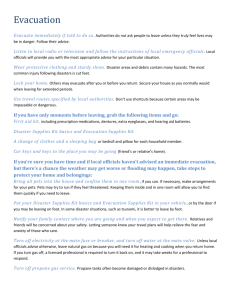
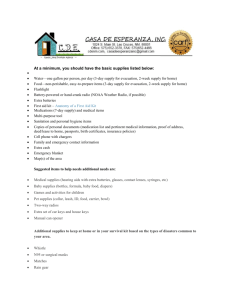

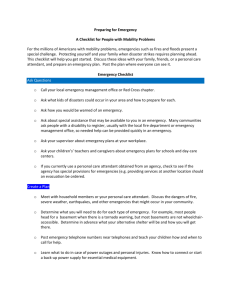
![Emergency Preparedness Checklist []](http://s3.studylib.net/store/data/007578463_2-030b7bdf6b3f06db2ba816477f51565c-300x300.png)


